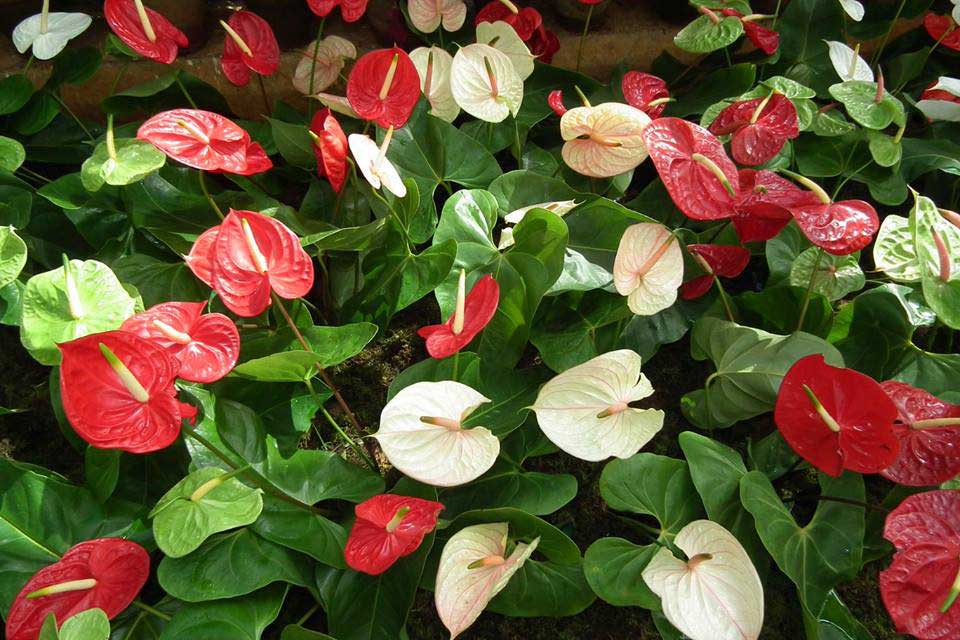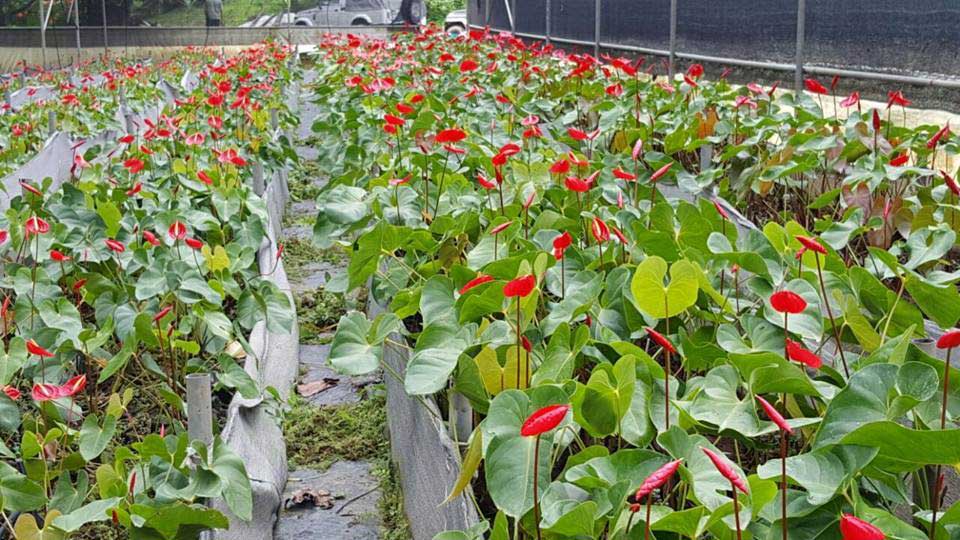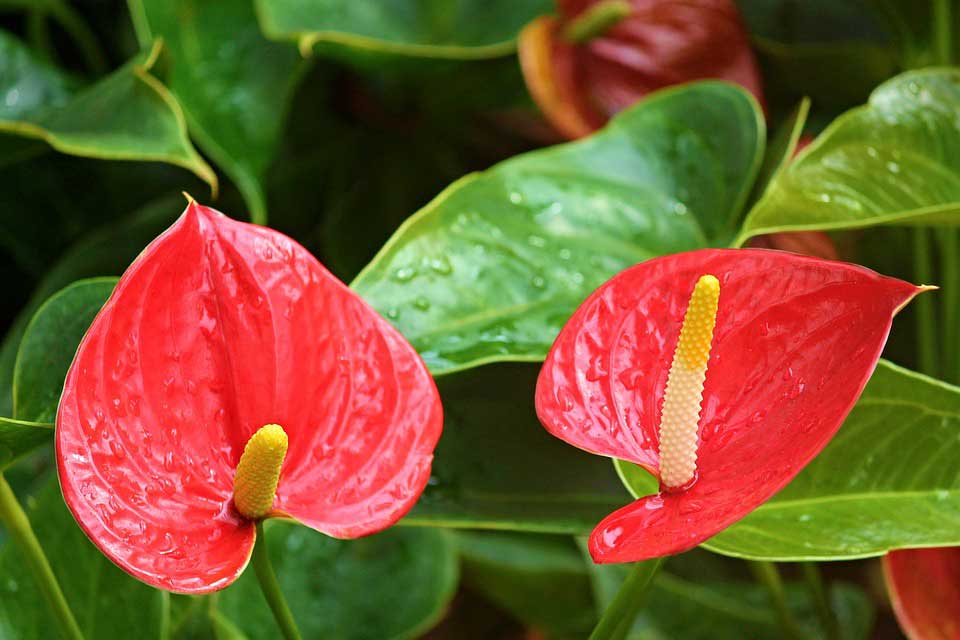Anthurium is a tropical ornamental plant, and Anthurium is cultivated for its colourful, long-lasting flowers or attractive foliage. They have gained importance as major cut flowers of the modern world.
Anthurium is a native of Central and South America and the genus Anthurium, with over 700 species.
The word anthurium is taken from the Greek ‘anthos’, flower, and ‘aura’ tail, referring to the spadix.
The major countries importing anthurium cut flowers are in the USA. Canada. Germany. Europe and Japan.
The popularity of growing anthurium as cut flowers has risen tremendously in the past few years, and it has now become an important export-oriented crop.
In India, the Anthurium industry is still in its starting phase. There are very few growers from Karnataka, Tamil Nadu, Kerala, Andhra Pradesh North -Eastern states who send their flowers to big cities like Mumbai and Delhi.
Anthurium requires a Greenhouse with shading for protecting from direct sunlight and maintain humid condition. Bright but a filtered light is essential for abundant flowering.
Climate
Anthurium is a tropical plant hence humid, and Moderate temperature condition is suitable for anthurium plant.
The ideal temperature for growing anthurium ranges from 27 – 30°C in the daytime and 10 – 20°C at night time. avoid Anthurium cultivation where temperatures are lower than 15°C and above 35°C
Anthuriums are not grown in the open tropical region; hence For Anthurium cultivation in a tropical climate, shade nets with 75% shading are used.
Growing medium

Anthurium plants require a growing medium in good physical and chemical conditions for their proper growth and development.
Highly organic, well-aerated growing media with good water retention capacity is suitable for anthurium cultivation.
Selection of good growing media is directly correlated with successful growing and production of export quality flowers in anthurium.
In India, the coconut husk is the primary growing media use for anthurium cultivation; this coconut coir pith must well-decomposed and washed thoroughly with good quality water to remove the soluble salts.
Then equal proportions of coir pith and coconut husk were used as growing media after washing in fungicide (Bavistin 0.2%) and insecticide (Chloropyriphos 0.3%).

Greenhouse structure required for commercial anthurium cultivation
For commercial purposes, anthurium is cultivated in the greenhouse. The greenhouse/ polyhouse required is a naturally ventilated type.
Foggers are fixed inside the greenhouse to control the humidity. Shade nets of 50%-75% are used to regulate the shade.
The temperature and humidity under the greenhouse were maintained throughout at about 20-28 °C and 70-85 percent RH.
Anthurium Varieties
There are many anthurium varieties with different colours like dark red, orange, white, pink, and bicolour (Two colours).
The preference for colour in global and local markets for anthurium flowers indicates that the red coloured varieties are the most favored with a 45 percent share among the varieties sold.
In India. Some of the varieties viz., Ivory (White), Chichas (Maroon) Aymara (Pink) and Jewel (Red with green), Tropical Red, Mauritius Red, Red Dragon, Verdun Red, Acropolis ( white), Mauritius White, Manoa Mist( white)
Preparation of bed

The bed consists of plastic foil (0.1cm thick), with a drainage tube for removing excess water at the lowest point.
The bed’s side consisted of a strong polystyrene sheet and a wire on posts covered with plastic sheet used to create the bed shape.
The bed has a width of 1.20 meters and a length of 26 meters. A path width of 0.8 meters was maintained.
Plastic is used to separate the substrate from the underground. The bottom of the bed was sloped from the side to the middle of the bed (2-3 cm) to drain water flows to the drainage hose.
A growing medium of coconut husk and coco peat was maintained at the thickness of 20-30 cm, which was disinfected by fungicides and pesticides. It is refilled after every two to three years of interval.
Bed Dimension
- No of bed per acre – 60-65
- The ideal length of the bed – 80-125 ft
- The ideal width of the bed – 4 Ft
Planting

The beds were irrigated two days before planting. When transplanting anthurium plant, maintain a distance of 30cm x 25 cm by making small holes of about 5-6 cm depth and width at each planting spot.
Plants were inserted in the holes carefully so that a plant’s roots should not touch the ground. Then, a handful of coir pith was put to avoid contact with the ground plastic cover.
Dead and diseased plants were discarded. Plants were sprinkled with water immediately after planting, and planting was done during evening time.
Irrigation
 The irrigation method was sprinkler irrigation through which fertilizers were also given, and the water used for irrigation must be 0.5 electrical conductivity above 1 electrical conductivity is not suitable for irrigation purpose.
The irrigation method was sprinkler irrigation through which fertilizers were also given, and the water used for irrigation must be 0.5 electrical conductivity above 1 electrical conductivity is not suitable for irrigation purpose.
In each bed, two sprinkler lines were maintained so that water reaches every plant very easily.
The plants are watered twice daily during summer and once in rainy, depending on environmental conditions. Even water was sprinkled twice a day over the paths in-between the beds to maintain the humidity.
Fertigation
The major nutrients nitrogen, phosphorus, and potassium were supplied in complex fertilizer grade 19:19:19.
Entire dosage (3:1:1) @ 2g/lit, twice a week during the vegetative period and 1:2:2 NPK mixture @ 2-3g /lit, twice a week were applied the flowering period.
Calcium nitrate and magnesium nitrate were also supplied through fertigation.
Greenhouse management
Before the greenhouse entry, make a small cementing structure for foot dip and add KMnO4 solution with water so that the hygienic condition of plants and greenhouse are maintaining.
Once every three years, change the cladding material and shade. While changing, take care, no sharp and pointed objects should contact the polyethylene cover so that no damage to the structure.
The door of the greenhouse was always close so that temperature and relative humidity are maintained.
Temperature and Relative Humidity management
The temperature and relative humidity maintained under the greenhouse are 20-28°C and 60-80%, respectively, With the help of a fogger and shade net.
Water is also sprinkled twice a day over the paths, in-between the beds to maintain the humidity.
Cultural practices

Weeding:
Hand weeding is required when weeds observe, and it is helpful to avoid competition with the crop.
Pruning of leaves:
Pruning of leaves was one of the important operations as too many leaves often lead to crooked stems and damaged flower buds.
The old and diseased leaves were pruned regularly, and only 3-5 leaves were maintained on the plant to get good quality flowers.
Plant protection measures:
The plant protection measures were taken as and when noticed with appropriate chemicals to prevent and control pests and diseases.
Harvesting and Grading –
The flowers were harvested after the unfolding of the spathe was complete. They were harvested in the morning and were cut with anthurium long stalks.
The best time for harvest was when 1/3 to 2/3 of the true flowers on the spadix were open. The flowers were cut with a sharp knife, leaving 3 cm of stem on the plants to prevent rotting of the stem.
Also, anthurium flower is withstanding for 20 days without damaging quality, so according to market need it harvested.
Flowers having any blemishes, black spots, discolored spathe, short stalk, and deformed flowers were removed before grading.
The flowers of spotlessly clean and shining were used; these Flowers were graded into five classes depending on their flower size in the Caribbean and Hawaii market standards.
The anthurium cut flower grades were as follows:
Grade Flower size (inch)
- Peewee <2.5
- Mini- 2.5-3
- Small – 3-4
- Medium- 4-5
- Large- 5-5.5
- Extra-large- 5.5-6
- Premium >6
Post-harvest handling

After harvest, the basal portion of the flower’s stalk was kept in water to prevent drying out. Flowers were cleaned with shampoo in clean water to remove the adhering particles of dust, pesticides, or fungicides for shining effect.
The care was taken while transporting flowers by placing a piece of cotton soaked in water at the end of the stem to
prevent desiccation.
Anthurium cultivation Economic
| Particular | Amount |
|---|---|
| Area of Polyhouse – 2008 square/meter | |
| Polyhouse Construction – Polyhous as per NHB norms, GI pipe structure & imported plastic @ Rs 825 / per Sq. mtr. | 1,656,600 |
| Irrigation System – Drip Irrigation system for plants Fertigation unit, Water Filtration unit | 150,000 |
| Shadnet – | 50,000 |
| Bed Preparation – Table stand with Wire ropes and Coco shells | 550,000 |
| Plants – Plant Density: 10 plants/sq.Mtr. Total No. of Plants: 20,000 Nos. Cost per Plant: Rs.125/plant | 2,500,000 |
| Total Investment | 4,906,600 |
| cost of cultivation per year | |
| Electricity – 3.0 unit/day | 50,000 |
| Water requirement – Approximate per year | 50,000 |
| Fertilizers – Water Soluble Fertilizers | 60,000 |
| Labour- 3- 4 labours per day | 250,000 |
| Crop Protection- Spraying | 30,000 |
| Packing Material Transport, Sales Commission | 162,000 |
| Miscellaneous – Maintenance, Depreciation | 490,660 |
| Subtotal | 1,092,660 |
| Returns Per Year | |
| Yield / Plant / Year- 6 flower | 120,000 |
| Flower Production
1Year: 3 Flower/year 2-5 Year: 7 Flower/year 6- 7 Year: 5 Flower/year | |
| Price per flower – avg price | 15 RS |
| Total Returns – Per Year | 1,800,000 |
| Cost of Cultivation -Per Year | 1,092,660 |
| Net Return-Per Year | 707,340 |
Disclaimer: (The above calculations are indicative only.)
Conclusion
Anthurium is the best-cut flower for export because of its leafless stem and good vase life. If cultivated scientifically, this crop can earn valuable foreign exchange for our country.




A very detailed and useful article for hobbyist and entrepreneurs.